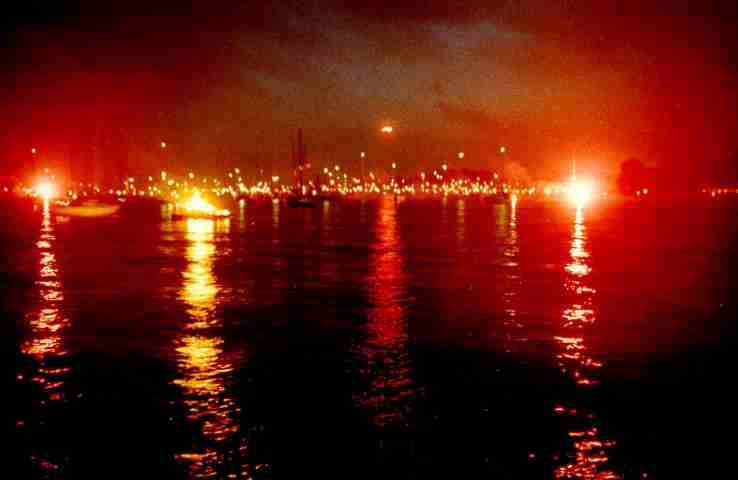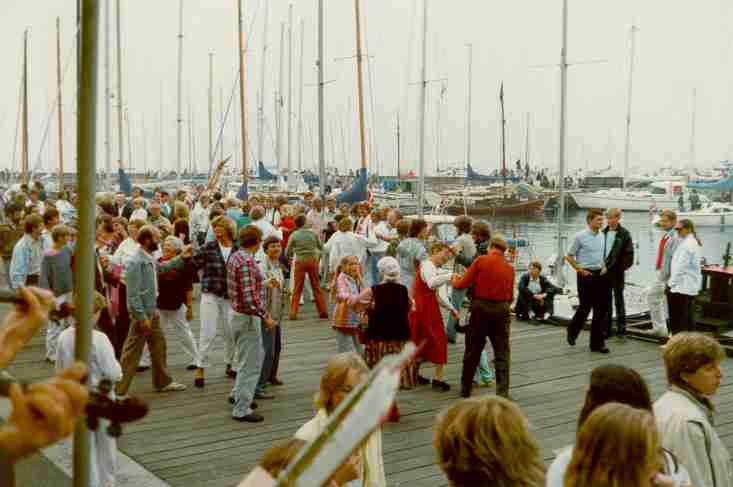
1000 tanker (1000 Thoughts)Sønderhoning (South ho dance) |
| Niels Mejlhede Jensen, Bøgeløvsvej 4, 2830 Virum, Denmark. e-mail (web master) |
CONTENTS: (remember: you can use Ctrl Home in usual browsers to get to the top of this page, to the links here)

Photo 1 of this week: Midsummer folk dancing on the wharf of
a small fishing village north of Copenhagen (Tårbæk, now mostly
a yacht harbour). It is almost 10 a clock a nice summer evening and still
not dark. From the music stand we can see across the water to Sweden in
the distance and here we play the nice Swedish melody Gärdeby
Gånglåt.

Photo 2 of this week: Celebrating the Midsummer Night on The Sound (Øresund), the water between Copenhagen and Sweden, with bonfire on floats and firework and lanterns on 100s of sail boats and yachts, as viewed from our music stand on the wharf getting close to midnight.
Dance of the week, 1999, May 3:
The melody can be heard in midi on computer piano in my tempo (if you
have a sound card). (The melody will loop here until you stop it. In the
table below it will play once. I have played it 2 times here above, with
the special ending, the special Fine, the 2' time. Below I have repeated
phrase 2 in all parts, all voices, and then with the special south ho Fine
ending). (I have not played the tunes here with the "drive" I want for
dance music).
| 1 | melody | the traditional good dancing melody, polished through generations of use on the fiddle | |
| . | chord
text |
Midi metronome = 100 | simple (folk music) chords, natural for playing the accordion;
these chords are used to make the other parts or voices in triad harmony; there should be no tension from dissonance anywhere including in octave |
| 2 | A | (Above), parallel part nearest above in third or little more above | |
| 3 | B | (Below), parallel part nearest below in third or little more below | |
| 4 | ns | simple n part; often with the tonic feeling and often with the basic dance rhythm ("motor part") | |
| 5 | C1 | C parts are made from A and B parts, and so they are two parts to the melody | |
| 6 | C2 | C2 is less simple than C1 | |
| 7 | n1 | voice up and down (mostly) contra to the melody; it is also made from A and B | |
| 8 | n2 | n is a less constricted part, and tones from the melody are freely included | |
| 9 | C1 | octave up | |
| 10 | C2 | octave up | |
| 11 | A | octave down | |
| 12 | blank | . | blank staff for making your own part according to the principles here |
(The midi music is not repeated, except that phrase 2 is repeated to
include the special ending, which is only used when the dance ends).
Use also octave, up and down.
Where wanted, notes can be changed according to the principles (use
a colour pencil), e.g. to improve the B part with some notes from
A.
The music is aimed at dancing, so part of the orchestra can be the
underlying "motor" when another instrument group is playing its "solo"
part (improvisation) as one of the many repetitions.
The double bass may play its usual notes, because of its low pitch.
It is better to choose a more simple part and play it well.
Accordion: beats per bar: 2+2, long uniform beats (not a short
chord beat like in polka), and a rather uniform sound level through the
beat without a too loud marked start of the beat).
Sønderhoning (south ho dance) can be played without a special
ending, but it is often included to show the ending of the dance. As it
can be seen from the music scores, the ending is made by altering the last
2 bars to 3 bars. The last 3 bars: bar 18, 19, and 20 are played with a
kind of stopping up on bar 18 beat 2 and bar 19 beat 1 with those tones
well marked (and non uniform). Use single bas + chord together on those
2 crotchet tones and on the 3 weaker finishing quavers. The 3 Fine bars
are only played the very last time.
(Help coming back from that note
sheet: CLICK the note sheet to come back to this page, or just close
the note window.
Remember: the note sheet opens in a new separate window, and that may
cover the whole screen. The back button in the tools bar does probably
not work because the window is new, with no history. All you see on the
page are notes because I have placed no link back here for not disturbing
easy submitting to the printer. Close the note window with a click at the
top or with Alt F4, or minimize or reduce the window, or ..., and you are
back to the main page that was there behind all the time).